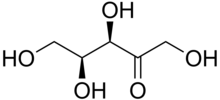Pentosuria
| Pentosuria | |
|---|---|
 | |
| Xylulose | |
| Specialty | Endocrinology |
Pentosuria is a condition where the sugar xylitol,[1] a pentose, presents in the urine in unusually high concentrations. It was characterized as an inborn error of carbohydrate metabolism in 1908.[2] It is associated with a deficiency of L-xylulose reductase, necessary for xylitol metabolism.[1][3] L-Xylulose is a reducing sugar, so it may give false diagnosis of diabetes, as it is found in high concentrations in urine. However glucose metabolism is normal in people with pentosuria, and they are not diabetic.[4] Patients of pentosuria have a low concentration of the sugar d-xyloketose.[5] Using phenyl pentosazone crystals, phloroglucin reaction, and absorption spectrum, pentose can be traced back as the reducing substance in urine, with those that have pentosuria.[6]
Research has shown that pentosuria appears in 3 forms. The most widely studied is essential pentosuria, where a couple of grams of L-xylusol are released into a person's system daily.[7] L-xylulose reductase, contained in red blood cells, is composed of both a major and minor isozyme.[8] For those diagnosed with essential pentosuria, the major isozyme appears to be the same as the minor one.[8] Alimentary pentosuria can be acquired through fruits high in pentose.[7] Finally, drug-induced pentosuria can be developed by those exposed to morphine, fevers, allergies, and some hormones.[7]
Those diagnosed with Pentosuria are predominantly of Jewish root.[1] However, it is a harmless defect, and no cure is needed.[9]
References
- ^ a b c "pentosuria". Encyclopædia Britannica. Retrieved March 26, 2013.
- ^ Scriver CR (October 2008). "Garrod's Croonian Lectures (1908) and the charter 'Inborn Errors of Metabolism': albinism, alkaptonuria, cystinuria, and pentosuria at age 100 in 2008". J. Inherit. Metab. Dis. 31 (5): 580–98. doi:10.1007/s10545-008-0984-9. PMID 18850300. S2CID 10154482.
- ^ Julia A. McMillan; Ralph D. Feigin; Catherine DeAngelis; M. Douglas Jones (1 April 2006). Oski's pediatrics: principles & practice. Lippincott Williams & Wilkins. pp. 1–. ISBN 978-0-7817-3894-1. Retrieved 5 January 2011.
- ^ Knox, W. Eugene (December 1958). "Sir Archibald Garrod's "Inborn Errors of Metabolism" IV.Pentosuria". The American Journal of Human Genetics. 10 (4): 385–97. PMC 1931884. PMID 13606116.
- ^ Greenwald, Isidor (17 May 1930). "The Nature of the Sugar in Four Cases of Pentosuria" (PDF). The Journal of Biological Chemistry. 88: 1,2. doi:10.1016/S0021-9258(18)76792-6.
- ^ Stookey, LB (1 May 1909). "Pentosuria". Experimental Biology and Medicine. 6 (5): 135–136. doi:10.3181/00379727-6-72. S2CID 209361414.
- ^ a b c B.Tower, Donald; Edmund L. Peters; Milton A. Pogorelskin (January 1956). "Nature and Significance of Pentosuria in Neuromuscular Disease". Neurology. 6 (137): 37–49. doi:10.1212/wnl.6.1.37. PMID 13280026. S2CID 24664586.
- ^ a b Lane, A.B. (February 1984). "On the Nature of L-Xylulose Reductase Deficiency in Essential Pentosuria". Biochemical Genetics. 23 (1–2): 61–72. doi:10.1007/bf00499113. PMID 3994659. S2CID 23655195.
- ^ Touster, Oscar (May 1959). "Pentose Metabolism and Pentosuria". The American Journal of Medicine. 26 (5): 724–39. doi:10.1016/0002-9343(59)90231-1. PMID 13649698.
External links